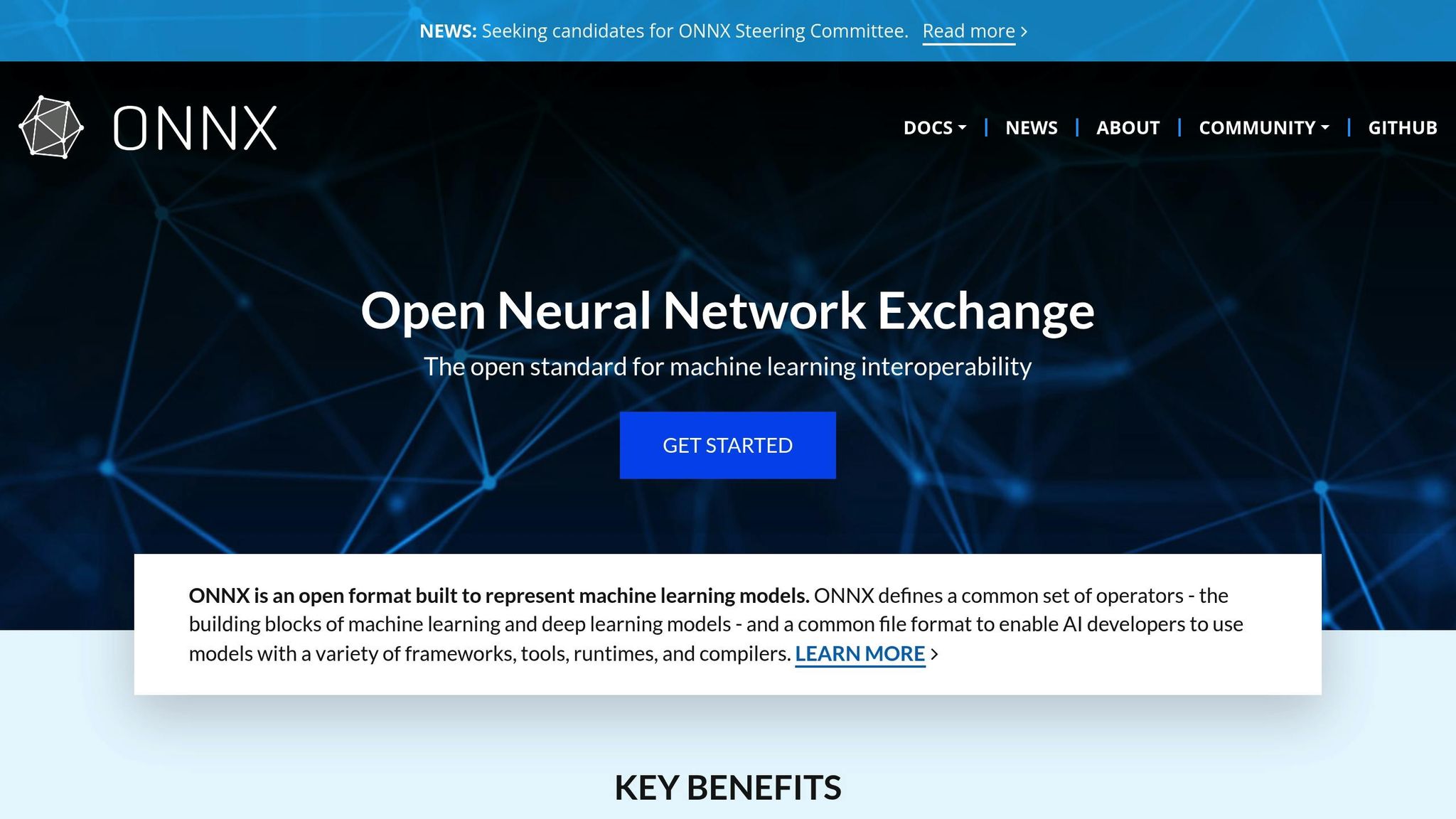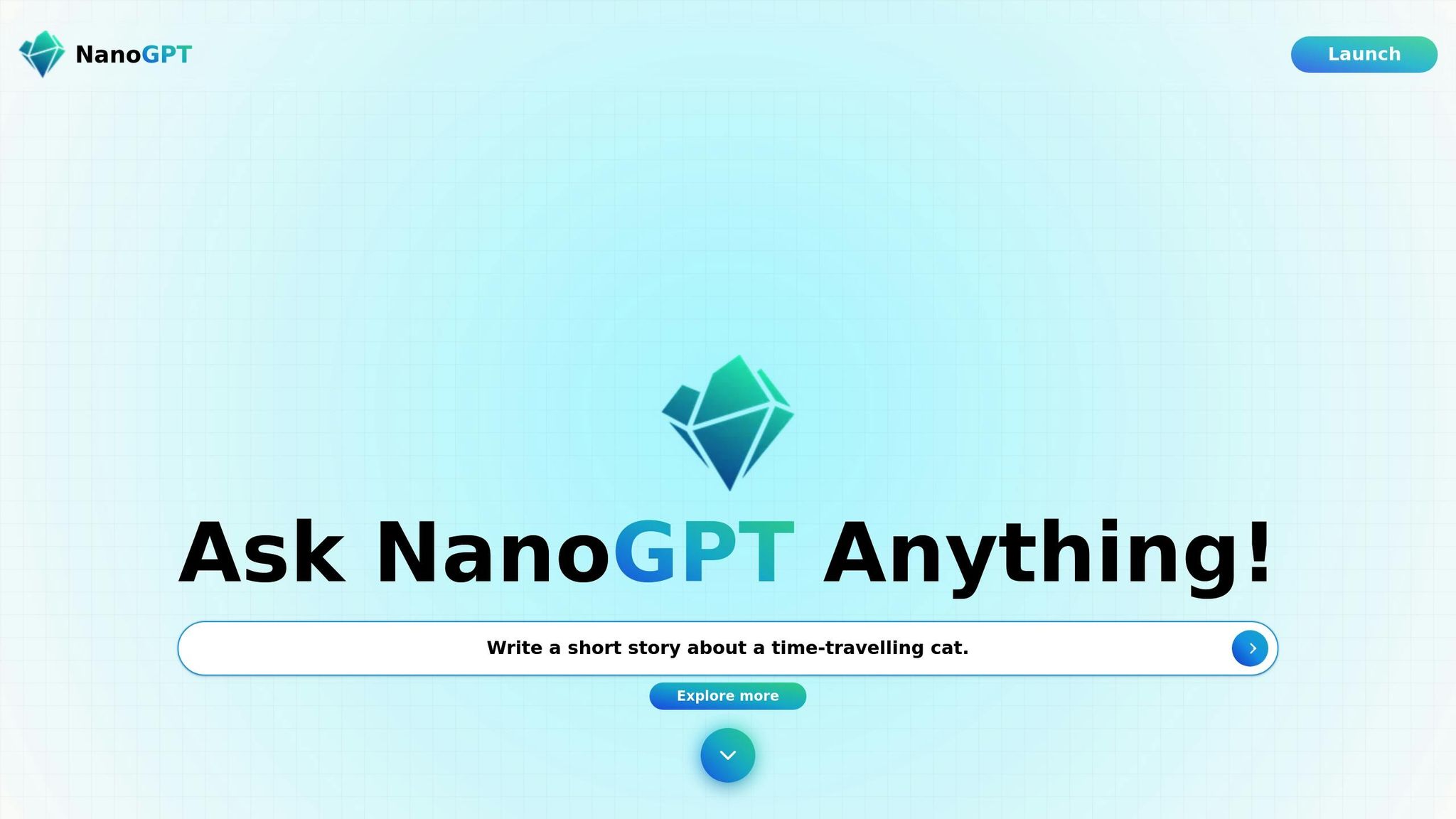May 4, 2025
ONNX makes it easier to use advanced AI models with older systems. It allows models to work across different frameworks like PyTorch and TensorFlow while ensuring compatibility with legacy hardware and software. Here's how ONNX helps:
For older systems, ONNX provides tools like version control, compatibility charts, and runtime locks to maintain backward compatibility. It also supports model conversion from popular frameworks (e.g., PyTorch, TensorFlow) and optimizations like quantization and graph optimization to improve performance on limited hardware.

Version control plays a key role in ONNX, helping models stay functional with older systems and different runtime setups. This ensures models behave consistently, regardless of the ONNX version or runtime environment.
Here are some methods ONNX uses to maintain backward compatibility:
| Method | Purpose | Implementation |
|---|---|---|
| Version Maps | Tracks operator updates between versions | Automates operator conversion |
| Compatibility Charts | Lists supported features for each version | Performs runtime validation checks |
| Runtime Locks | Keeps runtime behavior consistent | Uses version-specific containers |
Convert AI models to ONNX format for use in older systems by following clear steps for exporting, testing, and managing intermediate representations (IR).
Here’s how to export models from popular frameworks:
| Framework | Export Command | Key Notes |
|---|---|---|
| PyTorch | torch.onnx.export() |
Use dynamic axes for variable input sizes. |
| TensorFlow | tf2onnx.convert() |
Clearly define input/output data types. |
| Keras | keras2onnx.convert() |
Freeze batch normalization layers. |
For example, exporting a PyTorch model:
torch.onnx.export(
model,
dummy_input,
"model.onnx",
opset_version=9, # Ensures compatibility with older systems
do_constant_folding=True
)
After exporting, ensure the converted model works properly in the intended environment.
1. Input/Output Validation
Compare the outputs of the converted ONNX model with the original model using sample data. Check for matching data types, tensor shapes, and numerical accuracy.
2. Runtime Environment Testing
Run the model in the target ONNX runtime to assess memory usage and inference performance.
3. Error Handling
Watch out for common issues like:
Once runtime testing is complete, ensure the IR format aligns with the target system.
Maintain proper IR formatting by updating outdated operators, ensuring smooth data flow, and preserving the computational graph structure.
To check the model’s structural integrity and operator support, use the ONNX model checker:
import onnx
onnx.checker.check_model(onnx_model)
This tool helps confirm the model is ready for your specific runtime environment.
Improve the performance of ONNX models on older hardware by addressing resource limitations and optimizing for efficiency.
Here's how you can configure ONNX Runtime to make the most of available hardware:
import onnxruntime as ort
providers = [
('CUDAExecutionProvider', {
'device_id': 0,
'arena_extend_strategy': 'kNextPowerOfTwo',
'gpu_mem_limit': 2 * 1024 * 1024 * 1024 # 2 GB GPU memory limit
}),
'CPUExecutionProvider'
]
session = ort.InferenceSession("model.onnx", providers=providers)
Shrinking model size can help improve compatibility and performance on older systems. Here's a quick comparison of quantization methods:
| Quantization Type | Size Reduction | Accuracy Impact | Best For |
|---|---|---|---|
| INT8 Dynamic | High | Minimal | CPU inference |
| FP16 Static | Moderate | Very low | Older GPUs |
| INT8 Static | High | Slightly higher | Edge devices |
Example of applying dynamic quantization:
import onnxruntime.quantization as quant
quant.quantize_dynamic(
'model.onnx',
'model_quantized.onnx',
weight_type=quant.QuantType.QInt8
)
Optimize the computational graph to reduce memory usage and boost inference speed on older hardware.
from onnxruntime.transformers import optimizer
optimized_model = optimizer.optimize_model(
'model.onnx',
model_type='bert',
num_heads=12,
hidden_size=768
)
optimized_model.save_model_to_file('optimized.onnx')
session_options = ort.SessionOptions()
session_options.graph_optimization_level = ort.GraphOptimizationLevel.ORT_ENABLE_ALL
session_options.optimized_model_filepath = "fused_model.onnx"
session_options = ort.SessionOptions()
session_options.enable_mem_pattern = True
session_options.enable_mem_reuse = True
These steps not only enhance performance on older hardware but also prepare the model for efficient use in applications like NanoGPT's local processing pipeline.

NanoGPT leverages ONNX to enable local model execution, ensuring user data stays private. This approach supports smooth model performance across different hardware setups.
To handle models locally, you can configure ONNX Runtime with the following script:
import onnxruntime as ort
def configure_local_processing():
session_options = ort.SessionOptions()
session_options.enable_mem_pattern = True
session_options.setLogSeverityLevel(3) # Minimize logging for privacy
session_options.graph_optimization_level = (
ort.GraphOptimizationLevel.ORT_ENABLE_EXTENDED
)
return session_options
This setup not only optimizes local execution but also supports flexible pricing and strong privacy measures.
NanoGPT offers a usage-based pricing model starting at $0.10, making advanced AI tools accessible and cost-effective.
NanoGPT configures ONNX to securely run models on local devices, ensuring all data stays on the user's hardware:
def setup_private_session(model_path):
providers_config = {
'local_threads': 4,
'memory_limit': 1024 * 1024 * 1024, # 1GB
'fallback_policy': 'FALLBACK_TO_CPU'
}
session = ort.InferenceSession(
model_path,
providers=['CPUExecutionProvider'],
provider_options=[providers_config]
)
return session
This setup ensures all processing happens locally. A secure cookie is stored on the user's device to manage access credentials, eliminating the need for account creation.
This summary highlights how ONNX connects modern AI capabilities with older systems, allowing integration without the need for a complete infrastructure overhaul. By providing a standardized way to represent models, ONNX helps organizations adopt advanced AI while ensuring compatibility with existing frameworks and hardware.
The integration of ONNX with NanoGPT showcases how legacy systems can support newer AI technologies while maintaining privacy and managing costs. This method lets organizations upgrade their AI infrastructure step by step, avoiding the disruption of large-scale changes. ONNX achieves this by standardizing model formats, supporting older hardware, managing version control, and enabling local processing.
By combining support for older systems with modern deployment options, ONNX offers a practical way for businesses to advance their AI capabilities. This allows companies to retain their current workflows while gradually implementing new technologies, ensuring smooth operations and steady progress.
ONNX acts as a key tool for organizations aiming to bridge the gap between older systems and modern AI, providing a solid framework for long-term technological development.
ONNX (Open Neural Network Exchange) bridges the gap between modern AI models and legacy systems by providing a standardized format for model representation. This allows advanced models to be converted into a format compatible with older hardware and software environments, ensuring seamless integration and functionality.
By enabling interoperability across different frameworks and platforms, ONNX simplifies deployment and reduces the need for extensive reengineering, making it easier to use cutting-edge AI technologies in legacy systems.
To convert AI models from frameworks like PyTorch or TensorFlow to the ONNX format, you typically follow these steps:
torch.onnx.export for PyTorch or the TensorFlow-ONNX converter (tf2onnx) to export your model to ONNX.ONNX simplifies interoperability between AI models and legacy systems, making it easier to deploy across diverse platforms. For detailed guidance tailored to your use case, refer to the official documentation of your chosen framework.
Optimizing ONNX models for older hardware involves several strategies to ensure efficient performance. Consider quantization, which reduces the precision of model weights and activations, making computations faster and less resource-intensive. Another approach is model pruning, which removes redundant or less significant parts of the model to reduce its size and computational demands.
Additionally, you can leverage hardware-specific optimizations by using ONNX Runtime with execution providers tailored for your hardware, such as CPU or GPU. These techniques can significantly enhance the performance of ONNX models while maintaining compatibility with legacy systems.